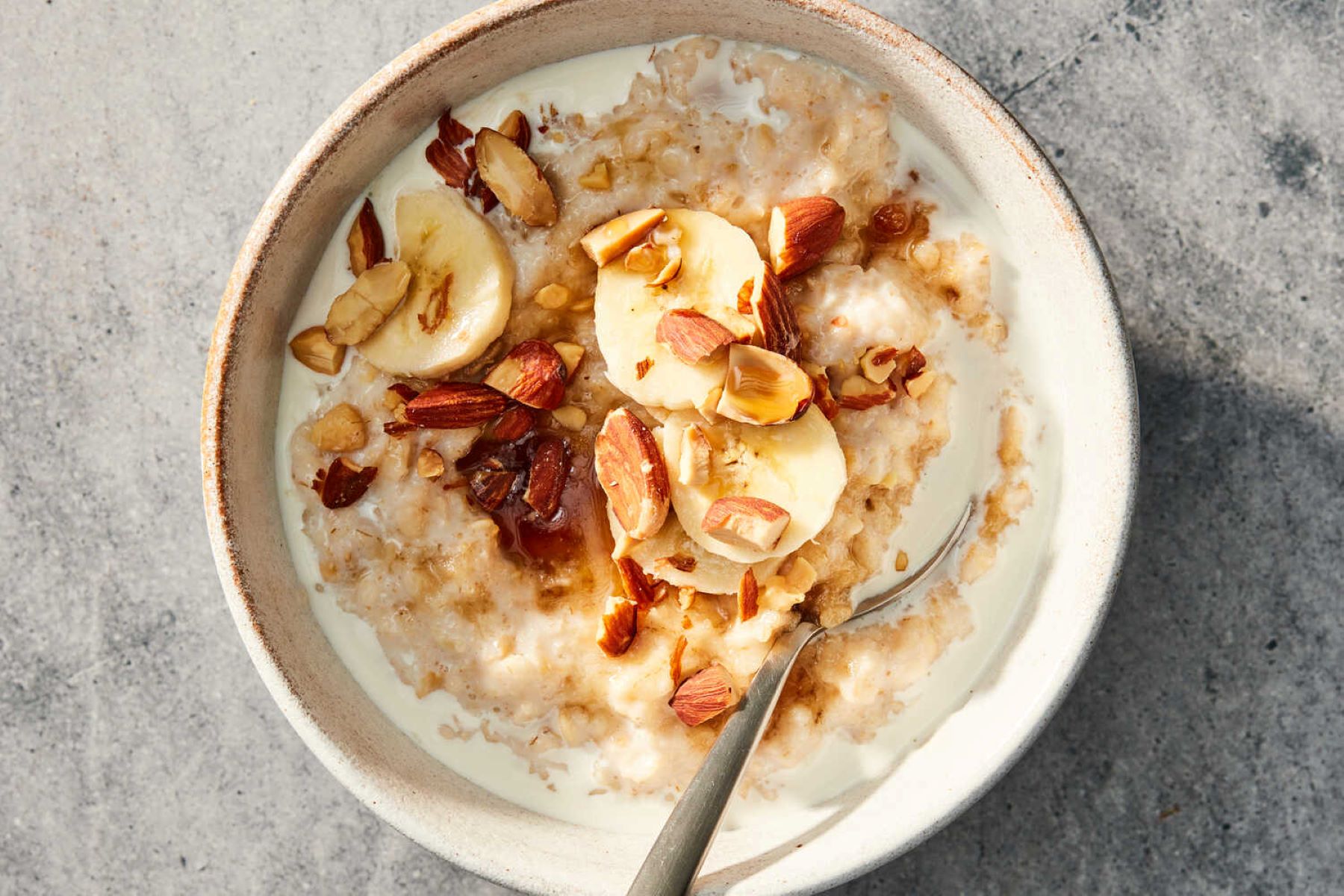Home>Food and Cooking>The Truth About Oatmeal: Is It Alkaline Or Acidic?


Food and Cooking
The Truth About Oatmeal: Is It Alkaline Or Acidic?
Published: January 20, 2024
Discover the truth about oatmeal and its alkaline or acidic properties. Get expert insights on food and cooking to enhance your knowledge.
(Many of the links in this article redirect to a specific reviewed product. Your purchase of these products through affiliate links helps to generate commission for Regretless.com, at no extra cost. Learn more)
Table of Contents
Introduction
Oatmeal has long been a staple breakfast food for many people around the world. It's a versatile dish that can be enjoyed in various forms, from creamy porridge to crunchy granola. Beyond its delicious taste and comforting texture, oatmeal has garnered attention for its potential impact on the body's pH levels. The debate over whether oatmeal is alkaline or acidic has sparked curiosity among health-conscious individuals seeking to understand the effects of different foods on their internal balance.
In this article, we will delve into the truth about oatmeal's pH properties, exploring its potential alkaline or acidic nature. Additionally, we will uncover the health benefits associated with consuming oatmeal, shedding light on why it remains a popular choice for those aiming to maintain a balanced and nutritious diet.
As we embark on this journey, it's essential to keep an open mind and consider the diverse perspectives surrounding oatmeal and its impact on the body's pH levels. By the end of this exploration, you will have a deeper understanding of oatmeal's role in the broader context of nutrition and overall well-being. Let's unravel the mysteries and misconceptions surrounding oatmeal's pH and discover the valuable insights that can empower us to make informed dietary choices.
What is Oatmeal?
Oatmeal, derived from the ground oats of the Avena sativa plant, is a widely consumed cereal that has been a dietary staple for centuries. It is commonly recognized for its versatility and nutritional value. Oats are processed to create various oatmeal products, including rolled oats, steel-cut oats, instant oats, and oat flour.
Types of Oatmeal:
- Rolled Oats: These are oat groats that have been steamed and flattened, resulting in a flake-like appearance. They are available in different thicknesses, with thicker flakes providing a heartier texture.
- Steel-Cut Oats: Also known as Irish or Scottish oats, these are made by cutting the oat groats into smaller pieces using steel blades. They have a chewy texture and are often favored for their robust, nutty flavor.
- Instant Oats: These oats are pre-cooked and dried, allowing for quick preparation by simply adding hot water or milk. They are convenient for those seeking a speedy breakfast option.
- Oat Flour: Ground from whole oats, oat flour is a gluten-free alternative to traditional wheat flour, making it suitable for individuals with gluten sensitivities.
Nutritional Profile:
Oatmeal is renowned for its impressive nutritional composition, making it a popular choice for health-conscious individuals. It is a rich source of complex carbohydrates, dietary fiber, and essential nutrients, including manganese, phosphorus, magnesium, and B vitamins. Oats are also notable for their high beta-glucan content, a soluble fiber recognized for its potential cholesterol-lowering effects and contribution to heart health.
Versatility and Culinary Applications:
Beyond its nutritional benefits, oatmeal's adaptability in the kitchen is noteworthy. It serves as a blank canvas for a myriad of flavor combinations and cooking methods. From sweet variations featuring fruits, honey, and nuts to savory options incorporating vegetables and spices, oatmeal can be tailored to suit diverse palates and dietary preferences.
In summary, oatmeal is a versatile and nutrient-dense cereal that has secured its place as a beloved breakfast choice for many. Its various forms and nutritional benefits make it an appealing option for those seeking a wholesome and satisfying start to their day.
The pH Scale
The pH scale is a fundamental concept in chemistry and biology, serving as a measure of the acidity or alkalinity of a substance. It ranges from 0 to 14, with 7 considered neutral. A pH below 7 indicates acidity, while a pH above 7 signifies alkalinity. This scale is crucial in understanding the potential impact of various substances, including foods, on the body's internal environment.
Acids, such as citrus fruits and vinegar, have a pH below 7, while alkaline substances, like baking soda and certain vegetables, possess a pH above 7. The human body strives to maintain a slightly alkaline pH, with a range of approximately 7.35 to 7.45, to support optimal physiological functions. This delicate balance is regulated by the body's buffering systems, which work to neutralize excess acidity or alkalinity.
When considering the pH of foods, it's essential to understand that the initial pH of a substance does not necessarily dictate its impact on the body's overall pH. While some foods may have acidic or alkaline properties outside the body, their influence on internal pH levels can be more complex. Factors such as digestion, metabolism, and the body's natural buffering mechanisms play a significant role in determining how a particular food affects the internal pH environment.
The relationship between food and pH is a topic of ongoing scientific inquiry, with researchers seeking to elucidate the nuanced interactions between dietary choices and the body's acid-base balance. This exploration has sparked interest in the potential health implications of consuming foods with varying pH levels, prompting individuals to consider the broader impact of their dietary habits on overall well-being.
In summary, the pH scale provides a valuable framework for understanding the acidity and alkalinity of substances, including foods, and their potential influence on the body's internal pH environment. While the initial pH of foods is a consideration, the complex interplay of digestion, metabolism, and buffering mechanisms underscores the multifaceted nature of dietary impacts on internal pH levels. This understanding serves as a foundation for ongoing research and informed decision-making regarding dietary choices and their potential effects on overall health.
Is Oatmeal Alkaline or Acidic?
The debate surrounding the alkalinity or acidity of oatmeal has sparked curiosity among health-conscious individuals seeking to understand the potential impact of this beloved breakfast staple on the body's pH levels. When evaluating the pH of oatmeal, it's essential to consider its initial pH as well as its potential effects on the body's internal environment.
Oatmeal, in its natural state, tends to be slightly acidic, with a pH ranging from approximately 5.0 to 6.0. This acidity is attributed to the presence of organic acids, such as phytic acid and avenanthramides, naturally occurring compounds found in oats. Despite its initial acidity, the broader impact of oatmeal on the body's pH levels is influenced by various factors, including digestion, metabolism, and the body's buffering systems.
Upon consumption, oatmeal undergoes a complex process of digestion and metabolism. As it travels through the digestive system, oatmeal's components are broken down and metabolized, leading to the release of nutrients and byproducts. While some foods may have acidic or alkaline properties outside the body, their influence on internal pH levels can be more nuanced. Oatmeal's interaction with the body's digestive processes and buffering mechanisms can result in a different impact on internal pH compared to its initial pH.
Furthermore, oatmeal contains significant amounts of dietary fiber, particularly beta-glucans, which have been linked to various health benefits, including potential effects on cholesterol levels and heart health. The presence of these beneficial compounds underscores the multifaceted nature of oatmeal's impact on the body, extending beyond its initial pH to encompass its nutritional and physiological effects.
In the broader context of nutrition, the focus on individual food pH levels has prompted scientific inquiry into the complex interplay between dietary choices and the body's acid-base balance. While the initial pH of foods is a consideration, the holistic understanding of how foods interact with the body's internal environment underscores the need for comprehensive research and informed decision-making regarding dietary habits and their potential effects on overall well-being.
In summary, while oatmeal may have an initial acidic pH, its impact on the body's internal pH levels is influenced by digestion, metabolism, and the body's natural buffering mechanisms. The broader nutritional and physiological effects of oatmeal, including its fiber content and potential health benefits, contribute to its significance in the realm of dietary choices and overall well-being.
Health Benefits of Oatmeal
Oatmeal is celebrated not only for its delightful taste and comforting texture but also for its array of health benefits that make it a valuable addition to a balanced diet. Let's explore the remarkable advantages that oatmeal offers:
-
Heart Health: Oatmeal is a rich source of soluble fiber, particularly beta-glucans, which have been associated with potential benefits for heart health. Consuming foods high in soluble fiber may help lower cholesterol levels, thereby reducing the risk of cardiovascular diseases.
-
Blood Sugar Regulation: The soluble fiber in oatmeal has also been linked to improved blood sugar control. It can slow down the absorption of glucose, contributing to more stable blood sugar levels and potentially reducing the risk of type 2 diabetes.
-
Digestive Health: Oatmeal's fiber content supports digestive health by promoting regular bowel movements and aiding in the prevention of constipation. Additionally, it provides a feeling of fullness, which may assist in weight management and overall digestive well-being.
-
Nutrient Density: Oatmeal is a nutrient-dense food, containing essential vitamins, minerals, and antioxidants. It is a good source of manganese, phosphorus, magnesium, and B vitamins, contributing to overall nutritional intake and supporting various bodily functions.
-
Weight Management: The fiber and complex carbohydrates in oatmeal can help individuals feel satiated for longer periods, potentially reducing overall calorie intake. This can be beneficial for those seeking to manage their weight as part of a balanced lifestyle.
-
Versatility and Customization: Oatmeal serves as a versatile canvas for incorporating an array of nutritious toppings and mix-ins, allowing individuals to tailor their oatmeal to meet their specific dietary preferences and nutritional needs.
-
Gluten-Free Option: For individuals with gluten sensitivities or celiac disease, oatmeal can be a valuable gluten-free alternative, provided it is sourced from uncontaminated oats and certified as gluten-free.
Incorporating oatmeal into one's diet can offer a host of health benefits, making it a compelling choice for those seeking to optimize their overall well-being. Whether enjoyed as a warm bowl of oatmeal topped with fruits and nuts or utilized in creative recipes such as oatmeal-based smoothies or baked goods, oatmeal stands as a versatile and nutritious addition to a wholesome diet.
The diverse advantages of oatmeal underscore its significance in promoting a balanced and health-conscious approach to nutrition, emphasizing the importance of incorporating nutrient-rich foods that contribute to overall wellness.
Read more: The Truth About The Word “Hoe”
Conclusion
In conclusion, the debate over whether oatmeal is alkaline or acidic reveals the complexity of understanding the broader impact of foods on the body's internal pH levels. While oatmeal may have an initial acidic pH, its interaction with the digestive system, metabolism, and the body's natural buffering mechanisms contributes to a more nuanced assessment of its overall influence on internal pH. This highlights the importance of considering the multifaceted nature of dietary impacts and the need for comprehensive research to inform dietary choices.
Furthermore, the health benefits associated with oatmeal underscore its significance as a valuable addition to a balanced diet. From promoting heart health and blood sugar regulation to supporting digestive well-being and weight management, oatmeal offers a diverse array of advantages that align with the principles of holistic nutrition. Its nutrient density, versatility, and potential as a gluten-free option further enhance its appeal as a wholesome and adaptable food choice.
As individuals navigate the landscape of nutrition and dietary decisions, the exploration of oatmeal's pH properties and health benefits serves as a reminder of the interconnectedness of food, health, and well-being. Embracing a holistic approach to dietary choices involves considering not only the individual properties of foods but also their broader nutritional and physiological impacts.
Ultimately, the truth about oatmeal's pH lies in its multifaceted nature, encompassing not only its initial acidic properties but also its potential health contributions and culinary versatility. By fostering a deeper understanding of the complexities surrounding oatmeal and its role in promoting overall wellness, individuals can make informed dietary choices that align with their health goals and preferences. Oatmeal, with its rich nutritional profile and potential health benefits, continues to hold its place as a beloved and nourishing addition to the diverse tapestry of dietary options.
In the journey of exploring dietary choices and their impact on well-being, the truth about oatmeal's pH serves as a reminder of the intricate interplay between food, health, and the pursuit of balanced nutrition. As we continue to unravel the mysteries and misconceptions surrounding dietary components, let us embrace a holistic and informed approach that celebrates the diverse contributions of foods like oatmeal to the tapestry of nourishment and well-being.














